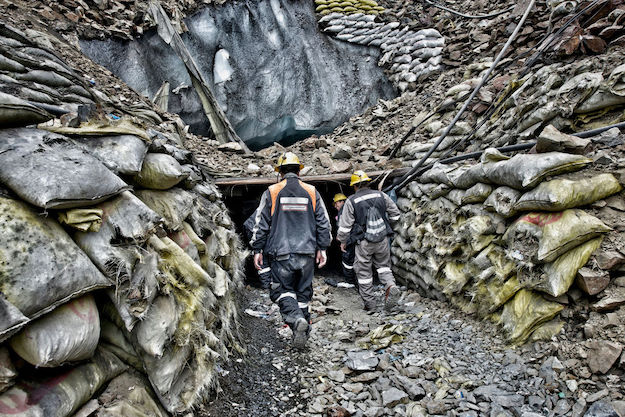The Peruvian town of La Rinconada, the highest permanent settlement in the world, is perched between soaring peaks and imposing glaciers. Its inhabitants are in one way or another supported by gold mines bored in the mountainside. Income from the ore extracted in its tunnels passes to the shops, bars and prostitutes in town. The gold itself will eventually find its way into the earrings of a debutante in New York or the watch of a businessman in Hong Kong.
But as Marie Arana argues in her highly acclaimed Silver, Sword, and Stone: Three Crucibles in the Latin American Story, La Rinconada also speaks to century-old traditions – and a history that, as the region reckons with deep-seated social and economic inequalities, systemic racism and persistent violence, can help illuminate a path forward for policymakers.
Following superstitions passed down through the generations, miners at La Rinconada still make offerings to the lord of the underworld El Tío, who supposedly repays the favor by protecting them from mine collapses, toxic fumes and other hazards. And even before Columbus’ arrival in the New World, the Incas and Mayans maintained mines not dissimilar to that of La Rinconada, indicating the persistent role of mineral wealth in shaping the continent.
Silver, Sword, and Stone looks to these and other intersections in Latin America’s past and present to help explain the current state of the region. Arana uses the three pillars of silver (representing mineral extraction as a whole), sword (describing violence and conquest) and stone (speaking to religions, both ancient and modern) as lenses through which to glean insights into what has shaped modern Latin America and, pressingly, why the region has suffered such constant ills.
Rather than tell the story chronologically, Arana divides the book into three sections. Each expounds on one of the three titular subjects, and she seamlessly blends the complicated history of pre-Columbian empires, post-Columbian conquest, the development of modern Latin America, and the strongmen, oligarchs, and other unsavory characters that continue to plague the continent into the present.
With sober, discerning prose, Arana first takes readers through the region’s history of mineral extraction, starting with that of the Incas, Aztecs and Mayans. Before the arrival of Europeans, she explains, gold was a symbol of the divine and using it for utilitarian purposes like currency was out of the question – the Incan ruler Pachacutec even banned its use for anyone outside of the royal family.
Arana wisely lavishes attention on the traditions, beliefs and structure of pre-colonial society. This helps demonstrates the changes wrought by the early 16th-century arrival of Hernán Cortes, Francisco Pizarro, and the myriad of other opportunists and plunderers who descended on the New World, but also the continuities that carried through the colonial period, and far beyond. For instance, the violence of pre-Columbian America, with its inter-tribal warfare, intra-empire strife, and human sacrifices, was continued through the Europeans’ use of the sword as they slaked their thirst for wealth.
The process of breaking away from the European masters, led by figures Simón Bolívar and Cuban essayist and nationalist José Martí, led to further bloodshed. And, even after South American countries supposedly won their independence, mostly in the 1820s, many fell under the control of new masters: (often light-skinned) oligarchs and dictators who were often as fixated on extracting wealth from their countries as the colonizers before them. Arana sees this violent past as significant in explaining the ills of the present day.
Of course, the statistics are one indication of the severity of contemporary violence in Latin America – one recent count suggested that 43 of the world’s 50 most violent cities are in the region. But Silver, Sword, and Stone also shows that violence is more deeply ingrained than even the numbers suggest. Similar to how a mother’s stress during pregnancy can adversely affect the health of a child, the trauma perpetrated and endured by previous generations of Latin Americans has engendered modern-day dysfunction. As Arana puts it: “Whether or not science ever establishes conclusively that violence, fear, or cowardice can be genetically coded in the human helix, for centuries we have believed it to be so… Perhaps it is why we have learned to witness history with a certain helplessness.”
The final section of the book focuses on stone: the development of spirituality and organized religion in South America. Stone not only represents the naturalistic origins of many native religions, but its sacredness also “seems to have united the spiritual life of the indigenous throughout the hemisphere.” As in the rest of the book, Arana makes sure to pay attention on the rich culture of pre-Columbian societies. But after the arrival of Christianity, the temples of the Incas and Mayans were repurposed as churches, and a program of conversion sought to replace traditional belief systems. Obviously, many native religions persisted or were blended with Christian teachings, as demonstrated by the Cora tribe of Mexico who created an amalgam of their Sun God and Jesus Christ, spawning elaborate ceremonies that continue to this day.
That said, for the vast majority of the continent, Catholicism was king. Around the turn of the century, around half of the world’s practicing Catholics lived in Latin America – a number that has since declined due to the rise of evangelicalism and the Catholic church’s image issues after siding with dictatorships time and time again in the 20th century, not to mention multiple sexual abuses scandals. Religion is still a central tenet of Latin American culture, but the reign of Catholicism that has endured for centuries may be coming to a close.
All told, Arana has crafted a book that strikes remarkable balance between pre-Columbian, colonial, post-colonial, and contemporary history while fleshing out the three guiding themes have shaped the continent. Amidst the history, she ties in the stories of three individuals that embody her “crucibles” of Latin American history: Leonor González, a longtime resident of La Rinconada; Carlos Buergos, who served with the Cuban military in Angola and came to America during the Cuban boat lift; and Xavier Albó, a Jesuit priest originally from Spain who came to Peru in 1952 to assist the people. While she clearly has a deep love for Latin America, one gets the sense that her outlook for the continent is not exactly bright – it is telling that, between González, Buergos, and Albo, only one emerges with a happy ending. Regardless, Silver, Sword, and Stone is a well-written, expansive dive into a history that is as urgent today as ever.
—
Crandall teaches politics at Davidson College and is the author of The Salvador Option: The United States in El Salvador (Cambridge, 2016); His upcoming book, out this fall, is Drugs and Thugs: The History and Future of America’s War on Drugs (Yale). Richardson is a 2019 graduate of Bowdoin College, where he studied history.







